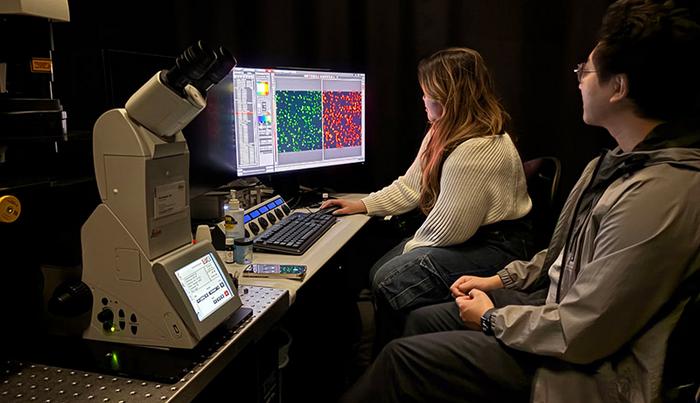Scientists at Rutgers University-New Brunswick have made a groundbreaking advancement in the field of biochemistry by transforming RNA, a crucial biological molecule ubiquitous in all living organisms, into an innovative biosensor capable of detecting minuscule chemicals that play critical roles in human health. This research is not just a theoretical exercise; it holds significant promise for real-world applications, particularly in the monitoring of environmental toxins and the early diagnosis of severe diseases such as cancers and cardiovascular disorders.
The innovative work builds upon the understanding of RNA, a type of nucleic acid that governs various cellular activities. The implications of this research could revolutionize medical diagnostics. Imagine a future where individuals visit healthcare facilities and provide samples of their own cells during routine check-ups. Researchers envision a scenario where the technology could convert these ordinary cells into sophisticated sensor cells, thereby retaining their natural characteristics and biological integrity. Such a system would potentially eliminate the body’s immune response, as the reintroduced cells are derived from the individual’s own body. This methodology could offer a more personalized approach to health monitoring by enabling these sensor cells to relay vital information regarding the presence of harmful chemicals or incipient health issues.
Published in the prestigious journal Angewandte Chemie International Edition, this research led by Assistant Professor Enver Cagri Izgu and his team demonstrates the effective integration of RNA in bacterial cells, allowing these cells and their progeny to detect specific chemicals with remarkable precision. Traditionally, RNA has been limited in its interaction with certain inorganic substances, making it challenging to develop effective genetic circuits for chemical sensing. However, this new approach overcomes these hurdles and innovatively utilizes RNA to interact with short-lived inorganic chemicals integral to various physiological functions, both in healthy individuals and those afflicted by illness.
The ingenious technique described in their study involves a unique receptor molecule that undergoes a chemical reaction with the target inorganic chemical. This interaction then allows the receptor to bind with a specially engineered RNA sequence, culminating in a binding event that results in light emission at a defined wavelength. The researchers successfully executed this chemical sensing mechanism within living Escherichia coli, which serves as an ideal model organism for such experiments. The ability to generate light as a response to chemical interactions not only provides a novel detection method but also adds an exciting visual dimension to the sensing process.
What is particularly striking about this research is its novelty. While there has been progress in producing custom-designed RNA within cells, no prior methods successfully employed RNA to actively detect small inorganic chemicals like hydrogen sulfide and hydrogen peroxide. The ability to achieve this in live bacterial systems opens new avenues for biosensing applications since changes in hydrogen sulfide and hydrogen peroxide levels have been tightly linked to the pathology of numerous conditions, including cancer and cardiovascular and neurological diseases.
Izgu emphasized the broader goal of this research: to harness the same techniques applied to bacteria and translate them into human cells. The vision is to modify human cells into sensor cells that could continuously monitor for critical biochemical changes. By replicating their success in E. coli, researchers hope to pave the way for innovative diagnostic technologies that could eventually lead to breakthroughs in personalized medicine, enhancing our capability to detect diseases earlier and with more accuracy.
Co-author Tushar Aggarwal, who is noted in the research as a former doctoral student in the Department of Chemistry and Chemical Biology, further contributes to the project’s impending commercial viability. Together with Izgu, he is a co-inventor on a patent application submitted on this pioneering work, which signifies the importance of their findings not only in academic circles but also in the potential marketplace for health technologies.
The research team also profiled other contributors who played vital roles in advancing the study. Liming Wang and Sarah Cho, both current doctoral students, along with former student Bryan Gutierrez, have been instrumental in pushing the boundaries of research in this area. Further contributions came from Huseyin Erguven, a previous postdoctoral associate, and Hakan Guven, a current student at Robert Wood Johnson Medical School, thus demonstrating a rich collaboration that spans multiple academic levels and expertise.
As the scientific community continues to explore and unravel the multifaceted functions of RNA, this research underscores the remarkable potential of RNA-based technologies. The findings not only expand our comprehension of the biochemical roles of RNA but also inspire future research endeavors aimed at enhancing human health through innovative biosensing methods.
With ongoing studies into RNA’s capabilities, further breakthroughs are anticipated, potentially leading to additional discoveries that may redefine how we approach disease prevention and surveillance. The unwavering commitment of researchers at Rutgers University signals an exciting shift toward a future where innovative biosensors could become commonplace in medical diagnostics, increasing the efficacy of early disease detection and environmental monitoring.
Ultimately, this research is a crucial step forward in the integration of computer-like sensing capabilities within biological systems, marrying the worlds of technology and biology into a cohesive unit that promotes health and wellness in unprecedented ways. As we look ahead to what these advances could mean for healthcare, it is clear that the fusion of RNA research with cutting-edge biosensing technology may fundamentally change our approach to human health and disease management.
As such, the promise of this groundbreaking research extends beyond the laboratory and invites us to envision a future where our biological systems actively work to safeguard our health by monitoring the very markers of disease from within.
Subject of Research: Cells
Article Title: A Small-Molecule Approach Enables RNA Aptamers to Function as Sensors for Reactive Inorganic Targets
News Publication Date: 17-Mar-2025
Web References: DOI 10.1002/anie.202421936
References: None
Image Credits: Enver Izgu/Rutgers University
Keywords: RNA, biosensor, human health, disease detection, environmental monitoring, Escherichia coli, cancer, cardiovascular, neurological diseases, personalized medicine.




